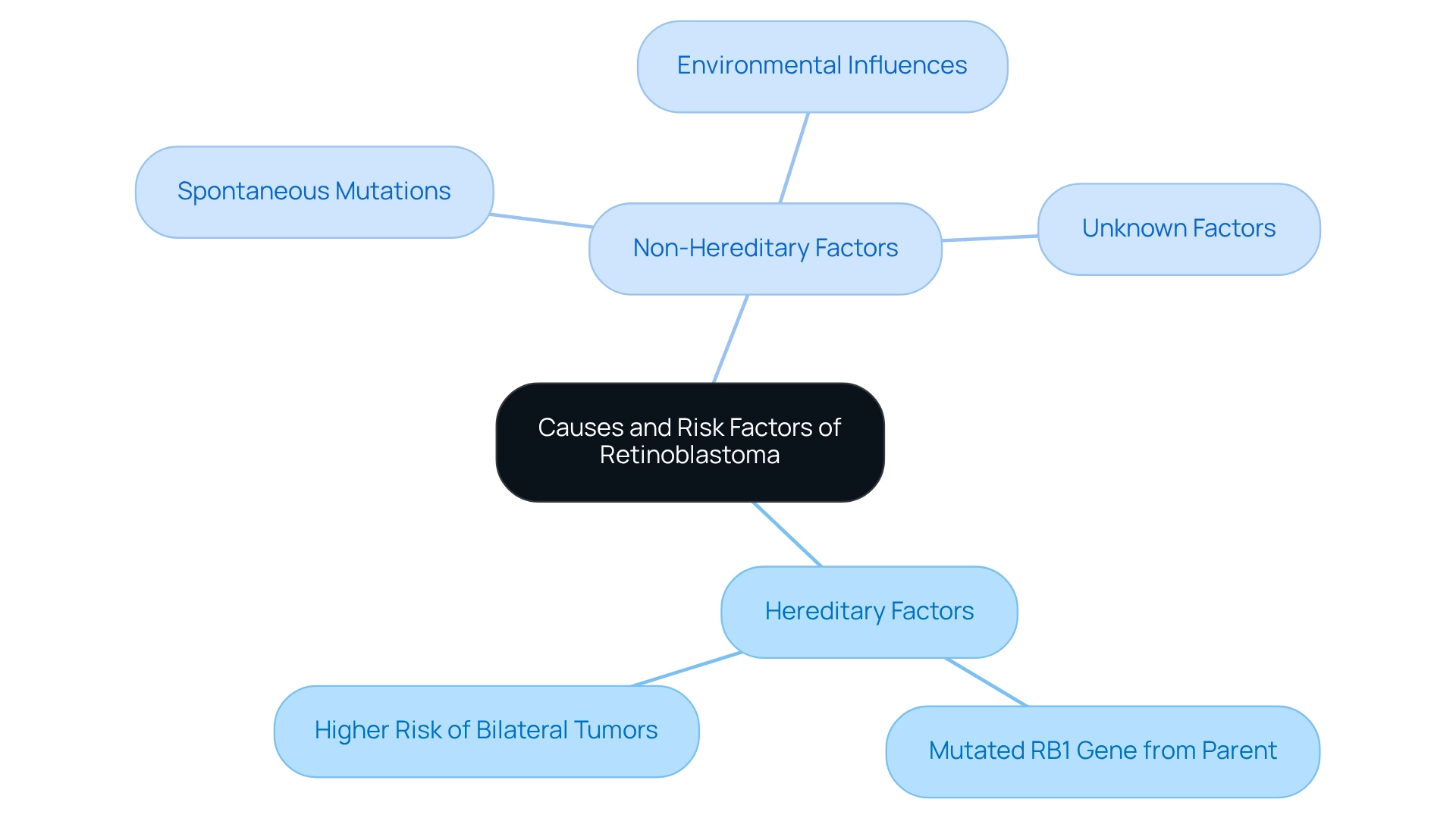Posted by: Northwest Eye in General on May 24, 2025
Overview
Retinoblastoma is a rare childhood cancer that primarily affects children under five years old, originating in the retina. If not treated promptly, it can lead to vision impairment. We understand how concerning this can be for families. Early detection is crucial, and being aware of symptoms like leukocoria can make a significant difference.
There are various treatment options available, including:
- Chemotherapy
- Laser therapy
These treatments have shown promising results in preserving vision and improving survival rates. It’s common to feel overwhelmed by the information, but rest assured, we are here to help you through this process. Remember, you are not alone in this journey.
Introduction
In the realm of childhood cancers, retinoblastoma stands out as a rare yet critical condition that primarily impacts our youngest patients. We understand that facing such a diagnosis can be overwhelming for families.
Originating in the retina, this aggressive form of eye cancer can lead to devastating consequences if not detected early. With a significant prevalence among children under five, it is crucial to understand the intricacies of retinoblastoma—from its genetic roots and risk factors to the urgent need for early symptom recognition. This knowledge is paramount for caregivers and healthcare professionals alike.
As advancements in treatment options emerge, we want to emphasize the importance of education and awareness. It’s common to feel uncertain during this journey, but ensuring that affected children receive timely interventions is vital. These interventions not only preserve their vision but also enhance their overall quality of life.
We are here to help you through this process, providing the support and information you need.
Define Retinoblastoma: A Childhood Cancer Overview
Retinoblastoma is a significant but rare form of eye cancer that predominantly affects children, especially those under five years old. This cancer originates in the retina, the light-sensitive layer at the back of the eye, arising from immature retinal cells known as retinoblasts. It can manifest in one or both eyes, leading to uncontrolled cell growth that poses a serious risk of or loss if not diagnosed and treated swiftly. Retinoblastoma is the most prevalent malignant tumor of the eye in children and accounts for approximately 3% of all s.
We understand that the occurrence of this eye cancer remains a critical concern. in low- and middle-income countries (LMICs) aim to educate caregivers about the . These campaigns are essential for improving outcomes, as early detection can greatly increase the likelihood of successful intervention. Recent studies highlight the importance of of affected individuals, which can help identify those at risk and reduce unnecessary screenings for non-carriers. This targeted approach not only aids in early identification but also enhances the management of at-risk children, significantly improving their chances for timely intervention.
are essential for enhancing outcomes for patients with retinoblastoma. Clinical trials are presently in progress to investigate new therapeutic options, demonstrating a dedication to enhancing care for this vulnerable population. The incorporation of innovative therapies has shown promise in successful case studies for retinoblastoma, illustrating that early detection and thorough management strategies can lead to favorable outcomes, including the preservation of vision. As noted by the PDQ Pediatric Treatment Editorial Board, “The best way to cite this PDQ summary is: PDQ® Pediatric Treatment Editorial Board. PDQ .” This underscores the importance of utilizing authoritative resources in understanding treatment and management strategies.
Comprehending retinoblastoma, a type of [childhood cancer](https://nweyeclinic.com/?p=5974), and its effects on children’s vision is crucial. The impact of this childhood cancer extends beyond physical health, affecting emotional and psychological well-being. Therefore, awareness and education about retinoblastoma are vital for ensuring that children receive the necessary care and support. We are here to help you through this process.

Identify Causes and Risk Factors of Retinoblastoma
A daunting diagnosis of retinoblastoma is often triggered by changes in the RB1 gene, which is a crucial suppressor gene located on chromosome 13. These alterations can arise from hereditary or non-hereditary factors.
In cases where the condition of , children may receive a mutated RB1 gene from a parent, which significantly heightens their risk of developing eye cancer. This often occurs at a younger age and can lead to bilateral tumors, affecting both eyes.
For those facing , such as retinoblastoma, it typically results from spontaneous mutations in retinal cells. While there are other potential , such as environmental influences like exposure to certain chemicals or radiation, our understanding of these factors remains limited.
It’s important to note that, currently, there are no known lifestyle-related risk factors that can be modified to prevent this type of eye cancer.
We understand that receiving this information can be overwhelming. Please know that we are here to help you through this process and support you every step of the way.

Recognize Symptoms of Retinoblastoma for Early Detection
One of the most common early signs of retinoblastoma is leukocoria, characterized by a , which is crucial for . This may appear as a white or yellowish glow when light shines into the eye. Other symptoms to be aware of include:
- Strabismus, or
- Poor vision
- Discomfort
In some instances, the affected eye may seem , a condition known as buphthalmos, or it may show signs of misalignment.
As parents, it’s important to stay alert for any unusual changes in your child’s sight or vision. Symptoms may resemble , such as blocked tear ducts, which can also lead to tearing and mattering. If you notice any of these symptoms, we understand it can be concerning, and it’s crucial to seek immediate medical attention. Early detection is essential, as this eye cancer is highly treatable when identified in its initial stages. We are here to help you through this process.
Explore Treatment Options for Retinoblastoma
Treatment for retinoblastoma is customized based on various factors, such as the size and location of the mass, whether one or both eyes are involved, and the overall health of the child. We understand that this can be a challenging time for families, and we are here to help guide you through the options available. The primary :
- Chemotherapy: Often used to reduce tumor size before other interventions, chemotherapy can be administered systemically or through intra-arterial methods, which deliver the drug directly to the eye. Recent statistics show that chemotherapy, particularly with melphalan, can achieve a response rate of over 90% in certain cases, significantly enhancing the chances of .
- : This method uses focused light to target and destroy cancerous cells, making it particularly effective for smaller growths.
- : By freezing the growth, cryotherapy effectively kills cancer cells and is often used alongside other treatments.
- Radiation Therapy: In specific situations, especially when surgery is not an option, radiation therapy can be a crucial choice for controlling growths.
- Enucleation: In advanced cases where the tumor is of the affected eye may be necessary to prevent the spread of cancer.
have led to improved outcomes, with many children preserving their sight and achieving long-term survival. Ongoing research is exploring innovative therapies, including targeted approaches and immunotherapy, which show promise for enhancing care. For instance, a novel approach involving conditional replicating oncolytic adenovirus targeting the RB1 pathway is currently under Phase I evaluation, yielding encouraging early results, as noted by Paula Schaiquevich from the Hospital de Pediatría JP Garrahan.
We recognize the importance of of retinoblastoma. Regular follow-ups can help manage potential secondary malignancies and ensure . A case study titled ‘Long-term Monitoring of Retinoblastoma Patients’ highlights the critical nature of regular follow-ups for managing the health of survivors of retinoblastoma. The evolving landscape of pediatric ocular oncology underscores the importance of continuous education and adaptation in treatment strategies. Remember, we are here to support you every step of the way.
Conclusion
Retinoblastoma is a rare yet critical childhood cancer that requires immediate attention from caregivers and healthcare professionals. We understand that learning about its origins in the retina, the genetic risk factors linked to the RB1 gene, and symptoms like leukocoria can feel overwhelming. However, recognizing these signs early is essential; it can significantly improve the chances of successful treatment, ultimately preserving vision and enhancing the quality of life for affected children.
Advancements in treatment options, including chemotherapy, laser therapy, and cryotherapy, have shown promising results. These developments offer hope for many families facing this diagnosis. Ongoing research into targeted therapies and immunotherapy reflects a commitment to improving care for this vulnerable population. Furthermore, we cannot overstate the importance of long-term monitoring for survivors, as regular follow-ups are crucial in managing potential secondary health issues.
In conclusion, raising awareness and education about retinoblastoma is vital for ensuring timely interventions. By fostering a better understanding of this condition, caregivers can navigate the complexities of treatment and support their children effectively. Together, these efforts can lead to improved outcomes, allowing children to thrive despite the challenges posed by retinoblastoma.
Frequently Asked Questions
What is retinoblastoma?
Retinoblastoma is a rare form of eye cancer that primarily affects children, especially those under five years old. It originates in the retina from immature retinal cells known as retinoblasts and can occur in one or both eyes.
How common is retinoblastoma among childhood cancers?
Retinoblastoma is the most prevalent malignant tumor of the eye in children, accounting for approximately 3% of all childhood cancers.
What are the risks associated with retinoblastoma if not treated early?
If not diagnosed and treated swiftly, retinoblastoma can lead to uncontrolled cell growth, posing a serious risk of vision impairment or loss.
What initiatives are in place to help with the early detection of retinoblastoma?
Ongoing public health campaigns in low- and middle-income countries aim to educate caregivers about the early signs of retinoblastoma, which is essential for improving outcomes through early detection.
How does molecular genetic testing benefit families affected by retinoblastoma?
Molecular genetic testing can identify relatives at risk of retinoblastoma, reducing unnecessary screenings for non-carriers and enhancing the management of at-risk children.
What advancements are being made in the treatment of retinoblastoma?
Clinical trials are currently investigating new therapeutic options, and innovative therapies have shown promise in improving outcomes for patients, including the preservation of vision.
Why is awareness and education about retinoblastoma important?
Awareness and education are vital for ensuring that children affected by retinoblastoma receive the necessary care and support, as the impact of this cancer extends beyond physical health to emotional and psychological well-being.
Where can I find authoritative resources on retinoblastoma treatment and management?
Authoritative resources on retinoblastoma treatment and management can be found through organizations like the PDQ Pediatric Treatment Editorial Board and other reputable health information platforms.






